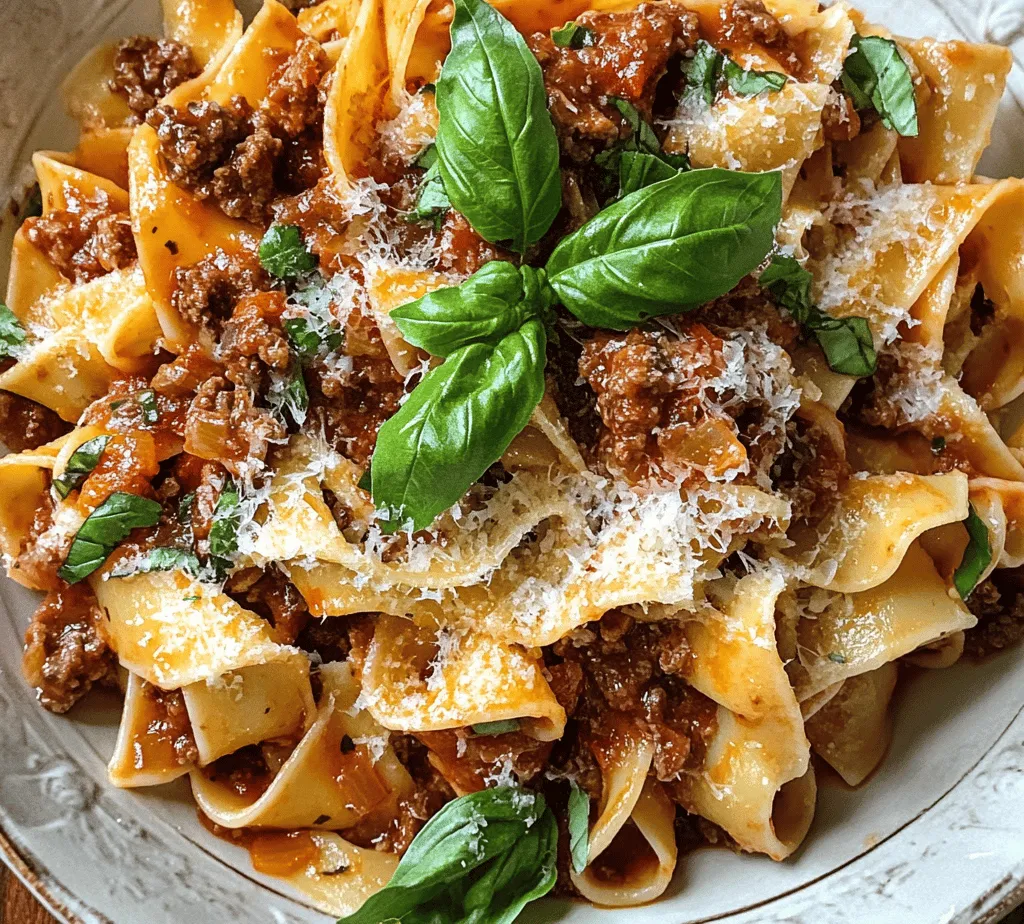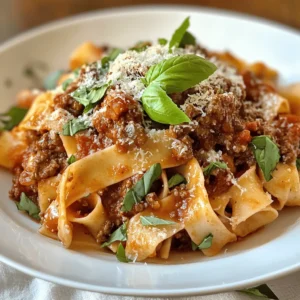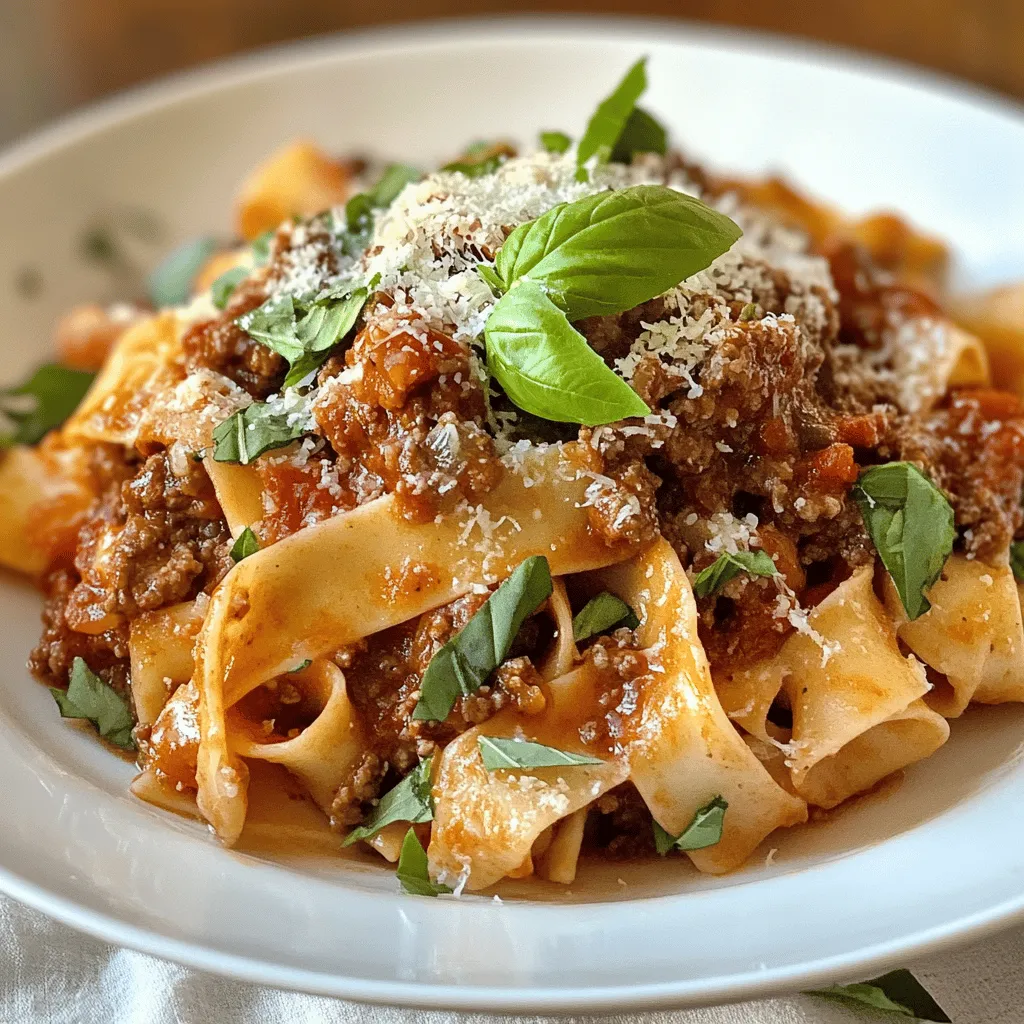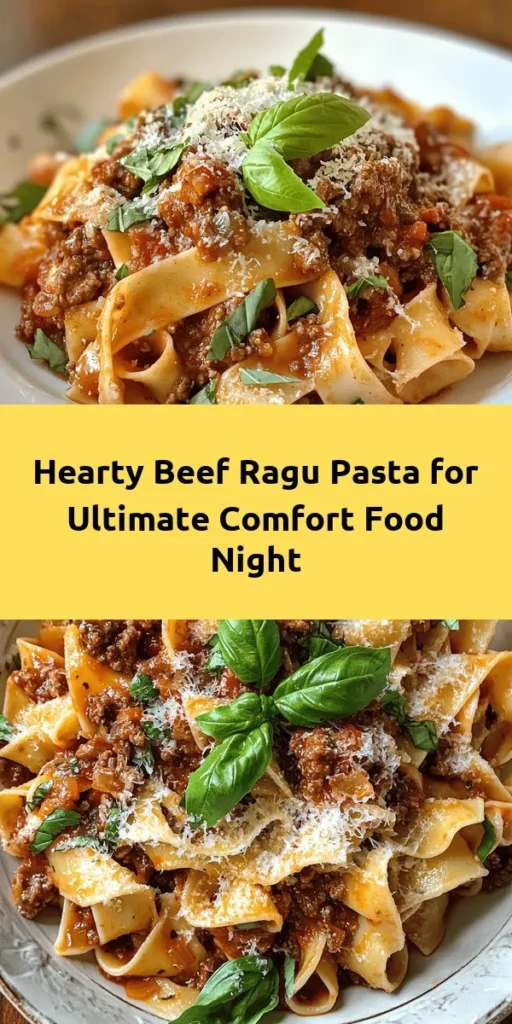When it comes to comfort food, few dishes can rival the rich, hearty goodness of Beef Ragu Pasta. Originating from Italy, this delectable meal is a staple in many households, celebrated for its depth of flavor and satisfying texture. Traditionally, ragu is a slow-cooked meat sauce that has been enjoyed for generations, and it pairs beautifully with a variety of pasta shapes. Whether it’s a family gathering or a cozy dinner at home, Beef Ragu Pasta has a way of bringing people together, making it a beloved choice for dinner tables around the world.
The allure of Beef Ragu Pasta lies not just in its taste, but also in the process of making it. The combination of simmered beef, aromatic vegetables, and a rich tomato sauce creates a symphony of flavors that dance on the palate. As the ingredients meld together, they create a dish that is both comforting and indulgent. With its complex layers of flavor, Beef Ragu Pasta is the perfect meal to prepare ahead of time, allowing the sauce to deepen in flavor and the pasta to soak up all the deliciousness.
Understanding the Ingredients
To truly appreciate Beef Ragu Pasta, it’s essential to understand the role each ingredient plays in creating this culinary masterpiece. Let’s delve into the key components that make this dish extraordinary:
Ground Beef: Best Cuts and Quality Tips
The star of Beef Ragu Pasta is undoubtedly the ground beef. When selecting the beef, quality is paramount. Look for ground beef that has a good balance of meat and fat—typically, an 80/20 ratio is ideal. This balance ensures that the beef remains juicy and flavorful during cooking. Cuts like chuck or brisket work particularly well for ragu, as they contain sufficient fat and connective tissue that breaks down during the slow cooking process, resulting in tender, melt-in-your-mouth meat. If possible, consider sourcing your beef from a local butcher for the freshest quality.
Olive Oil: Benefits and Flavor Contribution
Olive oil is the foundational fat used in this recipe, providing not only a medium for cooking but also an array of health benefits. Rich in monounsaturated fats and antioxidants, extra virgin olive oil is an excellent choice for sautéing the vegetables that form the base of the ragu. Its distinct flavor complements the dish beautifully, adding a layer of richness. When heating olive oil, ensure it is warm but not smoking, as overheating can diminish its flavor and nutritional properties.
Aromatic Vegetables: Role of Onion, Garlic, Carrot, and Celery
Aromatic vegetables are critical in building the flavor profile of Beef Ragu Pasta. The classic mirepoix of onion, carrot, and celery serves as the aromatic base.
– Onion: Provides sweetness and depth. Using yellow onions is common, but you can also experiment with shallots for a milder flavor.
– Garlic: Adds a robust, aromatic quality that elevates the overall taste. Fresh garlic cloves are preferable for their strong flavor, but pre-minced garlic can be a convenient alternative.
– Carrot: Contributes natural sweetness, balancing the acidity of the tomatoes. Finely diced or grated carrot integrates nicely into the sauce.
– Celery: Offers a subtle earthiness that enhances the overall complexity of the ragu. Like the carrot, it should be finely chopped to ensure even cooking and flavor distribution.
These vegetables are typically sautéed together until soft and fragrant, laying the groundwork for the entire dish.
Crushed Tomatoes and Tomato Paste: Their Significance in Creating a Rich Sauce
The tomato component of Beef Ragu Pasta is essential for achieving that signature sauce. Crushed tomatoes form the base, providing a luscious, tangy flavor. When selecting tomatoes, opt for high-quality canned varieties, as they are often picked at peak ripeness and packed with flavor.
Tomato paste is another vital ingredient that adds a concentrated burst of tomato flavor and helps thicken the sauce. By caramelizing the tomato paste during the cooking process, you enhance its sweetness and deepen the overall flavor of the ragu.
Herbs and Spices: Impact of Oregano, Basil, and Red Pepper Flakes
Herbs and spices are what truly elevate Beef Ragu Pasta from ordinary to extraordinary.
– Oregano: A classic Italian herb, oregano brings a warm, earthy flavor that complements the richness of the beef and tomatoes.
– Basil: Fresh basil adds a sweet, aromatic note. If fresh basil is not available, dried basil can be used, but add it earlier in the cooking process to allow its flavors to meld.
– Red Pepper Flakes: For those who enjoy a hint of heat, red pepper flakes can be added to taste. They provide a subtle kick that enhances the overall flavor without overpowering the dish.
Red Wine: When to Use It and How It Enhances the Sauce
Red wine is a classic addition to many ragu recipes, and for good reason. It adds depth and complexity to the sauce, enriching the overall flavor profile. When selecting a wine, choose a dry red wine, such as Chianti or Merlot, which will complement the beef and tomatoes beautifully.
The wine should be added after browning the meat and sautéing the vegetables. Allow it to simmer for several minutes, reducing it to concentrate the flavors before adding the tomatoes. This step not only enhances the sauce but also adds acidity, which helps balance the richness of the beef.
Pasta Selection: Best Types of Pasta to Pair with Ragu
Choosing the right pasta can significantly impact your Beef Ragu Pasta experience. Traditionally, wider pasta shapes like pappardelle or fettuccine are favored for their ability to hold onto the thick ragu sauce. However, other types of pasta, such as tagliatelle or even rigatoni, can also work well. The key is to select a shape that provides texture and can capture the sauce effectively.
When cooking the pasta, remember to salt the water generously. This step is crucial as it enhances the flavor of the pasta itself. Cook the pasta al dente, which means it should still have a slight bite to it, as it will continue to cook when combined with the sauce.
Step-by-Step Guide to Making Beef Ragu Pasta
Now that we’ve covered the ingredients that make Beef Ragu Pasta so special, let’s dive into the step-by-step process of creating this comforting dish.
Sautéing the Vegetables: Techniques for Softening and Flavoring
1. Begin by heating a generous amount of olive oil in a large, heavy-bottomed pot over medium heat.
2. Once the oil is shimmering, add the diced onion and cook for about 5 minutes, stirring frequently, until the onion is translucent.
3. Next, add the minced garlic, diced carrot, and chopped celery. Sauté the mixture for an additional 5-7 minutes until the vegetables are softened and fragrant. This step is crucial, as it develops the foundational flavors of the ragu.
Cooking the Beef: Tips for Browning and Draining Excess Grease
1. Once the vegetables are softened, increase the heat slightly and add the ground beef to the pot. Use a wooden spoon to break the meat apart as it cooks.
2. Cook the beef until it is browned and no longer pink, which should take about 8-10 minutes. Browning the meat is essential for developing rich, savory flavors.
3. After the beef is fully cooked, carefully drain any excess grease from the pot. This step will help prevent the sauce from becoming overly oily.
Adding Tomatoes and Wine: Balancing Flavors and Achieving the Right Consistency
1. With the beef browned and excess grease removed, it’s time to introduce the crushed tomatoes and tomato paste. Stir the mixture well to combine.
2. Pour in the red wine, scraping the bottom of the pot with a wooden spoon to release any flavorful browned bits. This technique, known as deglazing, adds depth to your sauce.
3. Allow the mixture to simmer for a few minutes, letting the wine reduce slightly before proceeding.
Simmering the Sauce: Importance of Time for Flavor Development
1. After the wine has reduced, add your herbs and spices—dried oregano, basil, and red pepper flakes—to the pot and stir to combine.
2. Lower the heat to a gentle simmer and let the ragu cook for at least 45 minutes to an hour, stirring occasionally. The longer the ragu simmers, the more the flavors will meld, resulting in a richer sauce.
3. If the sauce becomes too thick, add a splash of water or beef broth to reach your desired consistency.
As the ragu simmers, the aromas will fill your kitchen, creating an inviting atmosphere that makes it hard to resist. The anticipation builds as the sauce develops its depth, promising a delicious meal ahead.
Stay tuned for the next part of this article, where we will explore the final steps for perfecting Beef Ragu Pasta and serving it to your family and friends.

Cooking the Pasta: Best Practices for Achieving the Perfect Al Dente Texture
Cooking pasta might seem straightforward, but achieving the perfect al dente texture is crucial for a delicious Beef Ragu Pasta. Al dente, meaning “to the tooth” in Italian, refers to pasta that is firm to the bite while still being fully cooked. Here are some best practices to ensure your pasta reaches that ideal texture:
1. Use Plenty of Water: Start by bringing a large pot of water to a rolling boil. A good rule of thumb is to use about 4-6 quarts of water for every pound of pasta. This prevents the pasta from sticking together and allows it to cook evenly.
2. Generously Salt the Water: Once the water is boiling, add a generous amount of salt—about 1-2 tablespoons. The salt not only enhances the pasta’s flavor but also helps in achieving the desired texture.
3. Follow Package Instructions: Check the cooking time on the pasta package but start checking the pasta one or two minutes before the recommended time. This ensures you can catch it at the perfect al dente stage.
4. Taste Test: The best way to know if your pasta is al dente is to taste it. It should be firm but not hard in the center. If it’s still a little too firm, give it another minute or so.
5. Reserve Pasta Water: Before draining, reserve a cup of pasta cooking water. This starchy water can be added to your sauce later to adjust its consistency and help it adhere to the pasta.
Combining Pasta and Sauce: Techniques for Optimal Mixing
Once your pasta is perfectly cooked, it’s time to combine it with the Beef Ragu. Properly mixing the pasta with the sauce enhances flavor distribution and overall texture. Here’s how to do it effectively:
1. Drain the Pasta: After cooking, drain the pasta in a colander but do not rinse it. Rinsing removes the starch that helps the sauce cling to the pasta.
2. Add the Pasta to the Sauce: In a large skillet or saucepan, add the drained pasta directly to the Beef Ragu sauce. If your sauce is on the thicker side, you can add a splash of the reserved pasta water to loosen it up.
3. Toss Gently: Use tongs or a large spoon to gently toss the pasta with the sauce. This method ensures that each strand is coated without breaking it.
4. Simmer Together: For the best flavor, allow the pasta to simmer in the sauce for an additional minute or two. This step allows the pasta to absorb some of the sauce’s flavor, creating a more cohesive dish.
Serving Suggestions: Presentation Ideas and Garnishing Tips
Presentation can elevate your Beef Ragu Pasta from a simple meal to an impressive dish. Here are some serving suggestions and garnishing tips:
1. Plate with Care: Use a large serving bowl or individual plates. If using a bowl, twirl the pasta with a fork and spoon to create a nest-like appearance.
2. Garnish: Top your Beef Ragu Pasta with freshly grated Parmesan cheese, a sprinkle of chopped fresh basil or parsley, and a drizzle of high-quality olive oil. This adds flavor and a beautiful contrast against the rich sauce.
3. Serve with Bread: Accompany your dish with crusty Italian bread or garlic bread for dipping into the sauce.
4. Add Color: Consider serving a side of sautéed greens or a simple arugula salad with lemon vinaigrette to provide a refreshing contrast to the hearty ragu.
The Nutritional Benefits of Beef Ragu Pasta
Understanding the nutritional value of your meal can enhance your appreciation of the dish. Here’s a deeper look at the benefits of the key ingredients in Beef Ragu Pasta:
1. Protein Content from Ground Beef: Ground beef serves as the primary protein source in this dish. It is rich in essential amino acids that are vital for muscle repair and growth. A typical serving can provide a significant portion of your daily protein needs, making it a satisfying choice for a main meal.
2. Importance of Vegetables: The sauce typically includes a variety of vegetables, such as onions, carrots, and tomatoes. These ingredients are high in vitamins A and C, as well as dietary fiber, which is essential for digestive health. Tomatoes, in particular, are rich in lycopene, an antioxidant associated with various health benefits.
3. Consideration of Dietary Adjustments: For those looking for healthier or alternative options, consider using whole grain pasta, which contains more fiber and nutrients than traditional white pasta. Additionally, you can experiment with vegetarian alternatives by substituting ground beef with lentils, mushrooms, or plant-based meat products, making the dish suitable for various dietary preferences.
Cultural Significance of Ragu
Ragu is more than just a sauce; it represents a rich tradition in Italian cuisine that has evolved over centuries. Here’s a closer look at its cultural significance:
1. Historical Background: The origins of ragu can be traced back to Italy, where it has been a staple in many households. Traditionally, ragu was a way to utilize leftover meats, slow-cooked to create a hearty, flavorful sauce.
2. Regional Variations: Different regions of Italy have their own unique takes on ragu. For instance, Neapolitan ragu often includes pork and is served with pasta, while Bolognese (ragù alla Bolognese) is a meat-based sauce enriched with milk or cream. Understanding these variations adds depth to your appreciation of this dish.
3. Modern Adaptations: In contemporary dining, ragu has been adapted to suit modern tastes and dietary needs, including lighter versions and vegetarian interpretations. This Beef Ragu Pasta recipe blends traditional methods with modern touches, making it accessible for today’s cooks.
Pairing Suggestions for a Complete Meal
To enhance your dining experience with Beef Ragu Pasta, consider these pairing suggestions:
1. Ideal Side Dishes: A crisp side salad featuring mixed greens, cucumbers, and a simple vinaigrette complements the richness of the ragu. Alternatively, roasted vegetables or garlic bread are excellent choices that add texture and flavor.
2. Recommended Wines: A full-bodied red wine pairs beautifully with Beef Ragu Pasta. Consider options like Chianti, Sangiovese, or Barolo, which enhance the meatiness of the dish while balancing its acidity.
3. Dessert Ideas: To round off your meal, serve a light dessert such as panna cotta or tiramisu. These Italian classics offer a sweet contrast to the savory ragu and leave your guests satisfied.
Conclusion: A Hearty Meal to Savor
Beef Ragu Pasta is not just a dish; it’s an experience that brings comfort and joy. From the rich, savory sauce to the perfectly cooked pasta, every element contributes to a meal that invites sharing and enjoyment.
By following the steps outlined in this recipe, you can recreate a traditional Italian dish that honors its roots while fitting seamlessly into modern dining. The nutritional benefits, cultural significance, and pairing suggestions all add layers of appreciation to this hearty meal.
As you gather around the table to savor your Beef Ragu Pasta, remember that cooking is about connection and creativity. Encourage your family and friends to join you in the kitchen, making the preparation of this dish a collective effort. Enjoy the process, and relish the satisfaction that comes from sharing a delicious meal.



